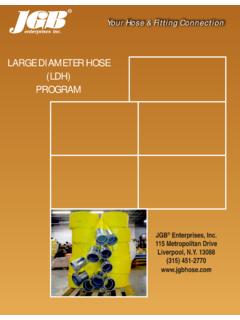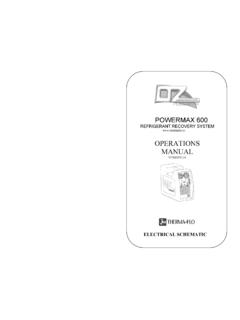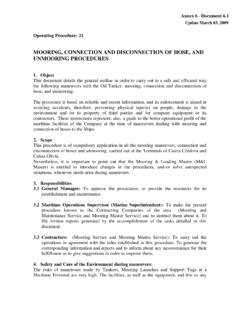Transcription of Hose Operations - fsrn.us
1 Hose OperationsHose OperationsLynbrook Fire Department Lynbrook Fire Department Training CommitteeTraining CommitteeIntroduction QQTypes and sizes of Fire HoseTypes and sizes of Fire HoseQQBasic Engine OperationBasic Engine OperationQQHose EvolutionsHose EvolutionsQQHose HandlingHose HandlingQQWater Flow (Volume)Water Flow (Volume)QQReachReachVocabularyQQVolumeVo lumeQQPressurePressureQQSingle Jacket Single Jacket QQDouble JacketDouble JacketQQOperating PressureQQReachReachQQLDHLDHQQF riction LossFriction LossQQSolid Bore NozzleSolid Bore NozzleQQFog NozzleOperating PressureFog NozzleBasics of Fire Hose QQNFPA 1961 NFPA 1961--Standard on Fire HoseStandard on Fire HoseQQLarger diameter hose can carry more water Larger diameter hose can carry more water at lower pressuresat lower pressuresQQSmaller diameter hose carry less water and Smaller diameter hose carry less water and require higher pressurerequire higher pressureTypes and Sizes of Fire HoseQQSuction HoseSuction Hose))5 or in some cases 6 5 or in some cases 6 QQAttack HoseAttack Hose))1 Booster Line1 Booster Line))1 3/4 1 3/4 ))2 1/2 2 1/2 QQSupply HoseSupply Hose))3 3 ))
2 5 5 Engine OperationsQQMove water through hose lines from a source of Move water through hose lines from a source of supply to the firesupply to the fireXXHydrantHydrantXXAnother EngineAnother EngineXXBody of WaterBody of Water))OceanOcean))Lakes, StreamsLakes, Streams))PoolsPoolsQQIncrease pressure as necessary to provide Increase pressure as necessary to provide proper nozzle pressure to fight the fireproper nozzle pressure to fight the fireSuction Hose-Hard SuctionQQHose that is designed to prevent collapse Hose that is designed to prevent collapse under vacuum conditions so that it can be under vacuum conditions so that it can be used for drafting water from below the used for drafting water from below the pump (lakes, rivers, wells, etc.). pump (lakes, rivers, wells, etc.). Attack HoseQQHose designed to be used by trained fire Hose designed to be used by trained fire fighters and fire brigade members to combat fighters and fire brigade members to combat fires beyond the incipient stagefires beyond the incipient stageQQAttack hose shall have a minimum design Attack hose shall have a minimum design operating test pressure of 275 operating test pressure of 275 psipsiXX1 Booster Line1 Booster LineXX1 3/4 hose1 3/4 hoseXX2 1/2 hose2 1/2 hoseAttack Hose-1 Booster LineQQRubber HoseRubber HoseXXUsed for Rubbish, Brush, Used for Rubbish, Brush, WashdownsWashdownsXXRequires High Pressure (approx.
3 200 Requires High Pressure (approx. 200 psipsi))XXDelivers low volume (approx. 50 gpm)Delivers low volume (approx. 50 gpm)XXHighly mobileHighly mobile--can be handled by 1 firefightercan be handled by 1 firefighterXXUses a fog type nozzleUses a fog type nozzleSource: Portsmouth, Va. FDAttack Hose-1 3/4 XXPrimary Attack Line for House Fires and Primary Attack Line for House Fires and Vehicle FiresVehicle FiresXXDouble JacketedDouble Jacketed--))275 275 psipsimax. operating pressuremax. operating pressureXXCan be operated by 2 Can be operated by 2--3 firefighters3 firefightersXXCan deliver 140 Can deliver 140--200 gpm200 gpmXXWorking pressure and volume varies with Working pressure and volume varies with nozzle typenozzle typeXXUsed with both solid bore and fog type nozzles Used with both solid bore and fog type nozzles Attack Hose-2 1/2 XXPrimary attack line in Commercial BuildingsPrimary attack line in Commercial BuildingsXXUsed to back up 1 3/4 linesUsed to back up 1 3/4 linesXXDouble JacketedDouble Jacketed))275 275 psipsimax.
4 Operating pressuremax. operating pressureXXNeeds 3 Needs 3--4 or more firefighters to operate4 or more firefighters to operateXXDelivers high volume of water (200 Delivers high volume of water (200--300 gpm)300 gpm)XXRelatively difficult to operate, especially in Relatively difficult to operate, especially in tight spacestight spacesXXUsually used with a solid bore nozzleUsually used with a solid bore nozzleFriction LossQQ Rule of Thumb HydraulicsRule of Thumb HydraulicsQQ1 3/4 Hose1 3/4 Hose--15 lbs. friction loss per 50 lbs. friction loss per 50 1/2 Hose2 1/2 Hose--5 lbs. friction loss per 50 ft. 5 lbs. friction loss per 50 ft. QQOptimal Fog Nozzle pressure is 100 PSIO ptimal Fog Nozzle pressure is 100 PSIQQO ptimal Solid bore Nozzle pressure is 60 Optimal Solid bore Nozzle pressure is 60 PSIPSIFlow Chart-Automatic Fog Nozzle vs.
5 Solid Bore Nozzle250 ft. 1 250 ft250 ft. 1 250 ft. 2 . 2 NozzleNozzlePressure100 100 psipsi140 gpm 140 gpm 200 gpm200 gpm60 60 psipsi202 gpm 291 gpm202 gpm 291 gpmSource: Task Force Tips, HoseQQUsed to supply an engine or tower ladder Used to supply an engine or tower ladder with water from a hydrant or another enginewith water from a hydrant or another engineQQSizesSizesXX3 3 XX5 5 Supply Hose-3 XXDouble JacketedDouble Jacketed--))275 275 psipsimax. operating pressuremax. operating pressureXXUsed to supply an Engine from the hydrantUsed to supply an Engine from the hydrantXXUsed to supply an Engine from another Engine Used to supply an Engine from another Engine (in(in--line pumping)line pumping)XXCan supply up to 600 gpm at 150 Can supply up to 600 gpm at 150 psipsiat a at a distance of 400 ft.
6 Distance of 400 ft. XXWill require a double lay for longer distances Will require a double lay for longer distances or greater volumesor greater volumesSupply Hose-5 XXSingle Jacketed Single Jacketed ))185 185 psipsimax. operating pressuremax. operating pressureXXUsed to supply an Engine from the hydrantUsed to supply an Engine from the hydrantXXMay be used to supply an Engine from another May be used to supply an Engine from another Engine (inEngine (in--line pumping)line pumping)XXCan supply 1000 gpm at 60 Can supply 1000 gpm at 60 psipsi(hydrant (hydrant pressure) at distances up to 1000 ) at distances up to 1000 move when chargedto move when chargedWater Weight6718098502004006008001000 Total Weightwith Water( )1 3/4" (50 ft.)3" (50 ft.)5" (100 ft.)Flow Comparison 3 & 5 HoseHose Pressure Volume Distance3 60 PSI350 GPM400 ft.
7 (Hydrant Pressure)5 60 PSI1500 GPM400 ft.(Hydrant Pressure)Source: Angus Fire -Hose CalcSummaryQQHose diameter is the most important factor in Hose diameter is the most important factor in determining volume of water delivereddetermining volume of water deliveredQQThe optimum pressure changes with the The optimum pressure changes with the diameter of the line diameter of the line --lower pressure is lower pressure is required in larger lines to move a given required in larger lines to move a given amount of wateramount of waterQQAttack lines are Booster Lines, 1 3/4 , 2 1/2 Attack lines are Booster Lines, 1 3/4 , 2 1/2 QQSupply Lines are 3 and 5 Supply Lines are 3 and 5 SourcesQQNational Fire Protection AssociationNational Fire Protection Fire Fire Force Tips, Force Tips, FireAngus











